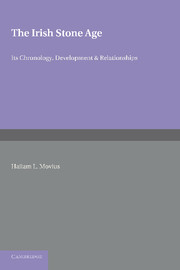Book contents
- Frontmatter
- Dedication
- Contents
- ILLUSTRATIONS
- FOREWORD
- PREFACE
- INTRODUCTION
- Part One THE CHRONOLOGY OF THE LATE-GLACIAL AND EARLY POST-GLACIAL PERIODS IN NORTHERN AND WESTERN EUROPE
- CHAPTER I The Chronology of Northern Europe
- CHAPTER II The Late-Glacial Sequence in Britain and Ireland
- CHAPTER III Early Post-Glacial Chronology in Britain and Ireland
- Part Two THE STONE AGE CULTURES OF IRELAND
- Appendices I-VI
- REFERENCES CITED IN THE TEXT
- CLASSIFIED LIST OF REFERENCES TO CAVE RESEARCH AND STONE AGE ARCHAEOLOGY IN IRELAND
- ADDENDUM
- INDEX
CHAPTER II - The Late-Glacial Sequence in Britain and Ireland
from Part One - THE CHRONOLOGY OF THE LATE-GLACIAL AND EARLY POST-GLACIAL PERIODS IN NORTHERN AND WESTERN EUROPE
Published online by Cambridge University Press: 05 June 2016
- Frontmatter
- Dedication
- Contents
- ILLUSTRATIONS
- FOREWORD
- PREFACE
- INTRODUCTION
- Part One THE CHRONOLOGY OF THE LATE-GLACIAL AND EARLY POST-GLACIAL PERIODS IN NORTHERN AND WESTERN EUROPE
- CHAPTER I The Chronology of Northern Europe
- CHAPTER II The Late-Glacial Sequence in Britain and Ireland
- CHAPTER III Early Post-Glacial Chronology in Britain and Ireland
- Part Two THE STONE AGE CULTURES OF IRELAND
- Appendices I-VI
- REFERENCES CITED IN THE TEXT
- CLASSIFIED LIST OF REFERENCES TO CAVE RESEARCH AND STONE AGE ARCHAEOLOGY IN IRELAND
- ADDENDUM
- INDEX
Summary
INTRODUCTION
Although this chapter, including the Appendices which go with it, is entirely a bibliographical study, not based upon actual field work, the material is presented in the hope that it will provide a tentative chronology for the Late-Glacial Period and lead to further research into the numerous problems involved. The writer was forced to embark upon this investigation to establish the necessary background, as determined by natural history, for the Stone Age settlement of Northern Britain and Ireland, and to work out provisional dates for the various events, so far as possible, on the basis of the North European sequence. In Britain there is an urgent need for broadscale chronological mapping of the drift sequence for the assistance of archaeologists, as Sandford points out (1935, P- 5°3)- The limits of glaciation have been known in England for a considerable period (Wright, 1914, p. 49), and it has long been an established fact that Ireland was entirely covered during the period of maximum advance. Notwithstanding the wealth of material on this subject, such loose statements as “at the maximum of the last ice all the British Isles were covered north of approximately latitude 52°” (Coleman, 1929, p. 34) are still made, and a glance at Dubois' maps (Daly, 1934, p. 77) reveals how inadequately the recession of the last ice-sheet in the region under discussion is generally understood. For the most part, hastily compiled information has led to a misrepresentation of the facts, and even Antevs' correlations (1929, pp. 663-7), although they reflect the advances made in this subject during the last ten years, are far from reliable. Before any really marked advance is made in British glacial geology, however, a uniform nomenclature for individual glaciations over the whole country must be evolved, as Harrison has stated (1937, p. 235). As yet no general system of this sort exists and in each district one finds a different set of labels for contemporary deposits. Whereas no complete synthesis of these data has yet appeared, the following is an attempt to outline the salient features and to offer a plausible interpretation based upon known facts. Certainly much remains to be done to fill in the gaps in our existing knowledge, since the region offers limitless possibilities for future research.
- Type
- Chapter
- Information
- The Irish Stone AgeIts Chronology, Development and Relationships, pp. 25 - 74Publisher: Cambridge University PressPrint publication year: 2013



